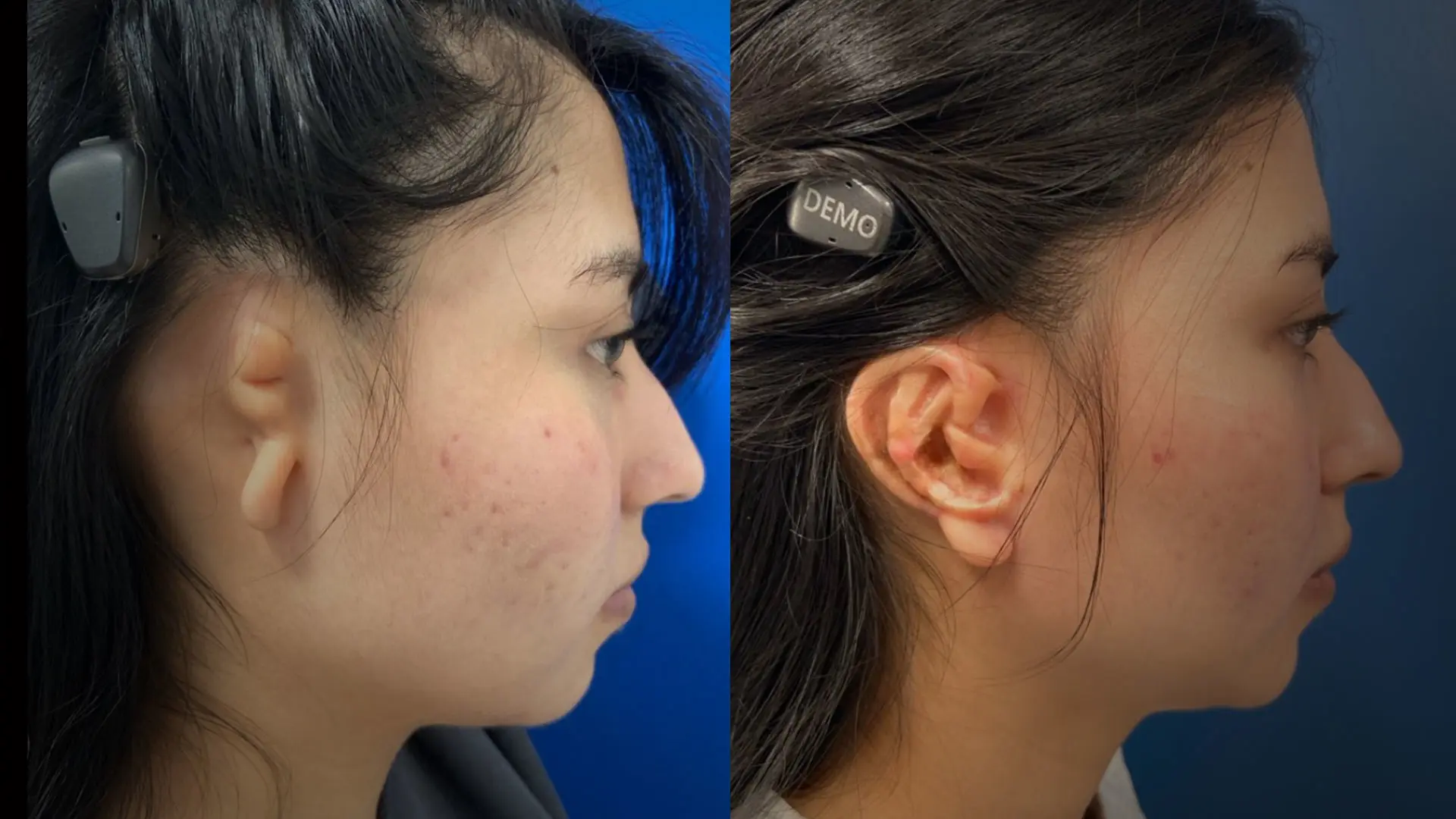Only a few hospitals in the world have specialized teams skilled in treating both hearing loss and microtia and atresia—rare congenital deformities affecting the outer ear and ear canal—making it hard for patients and families to find experienced providers to care for them.
That is what makes the multidisciplinary microtia and atresia team at the Ear Institute at New York Eye and Ear Infirmary of Mount Sinai so valuable to patients. The team provides a full suite of treatments to restore both form and function to children and adults.
Microtia exists on a spectrum, from a subtly folded lop ear to an ear that is entirely absent. It often goes hand in hand with aural atresia, in which the ear canal and middle ear structures do not fully develop. Most patients have some degree of hearing loss in the affected ear. Yet each case is different, requiring an individualized treatment approach.
“What’s unique about the Ear Institute is that we offer a truly comprehensive ear team that can address hearing restoration and reconstruction of the ear,” says Mingyang L. Gray, MD, Assistant Professor of Facial Plastic and Reconstructive Surgery at the Icahn School of Medicine at Mount Sinai.
Patients typically arrive at the Ear Institute after a referral from a pediatrician or audiologist in the community. The team works together to develop a treatment plan and timeline. The first priority is usually addressing hearing deficits, with interventions such as bone-anchored hearing aids or, in more severe cases, cochlear implants. When the ear canal is missing or narrowed, neurotologists perform atresiaplasty to recreate a functional canal. Then, to address the appearance of the external ear, plastic and reconstructive surgeons, including Dr. Gray, draw on advanced techniques to create a new ear using cartilage taken from the patient’s ribs.
Microtia Repair: Building an Ear
While hearing restoration procedures may begin earlier in childhood, Dr. Gray prefers to perform external ear reconstruction after age 6, when a typical ear is 70-80 percent developed. Most of her patients are between ages 8 and 12—a “sweet spot” when the unaffected ear is mostly developed and the rib cartilage is still flexible enough to shape easily. She also performs the procedure in older children and even adults.
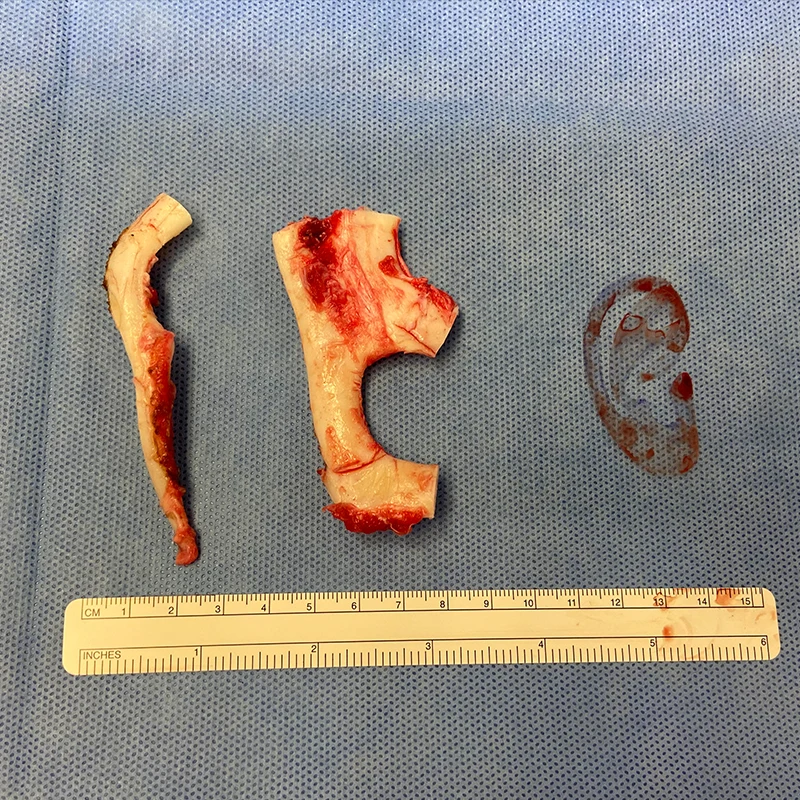
A template is created using a normal ear. Three pieces of rib cartilage are harvested to create a new ear framework.
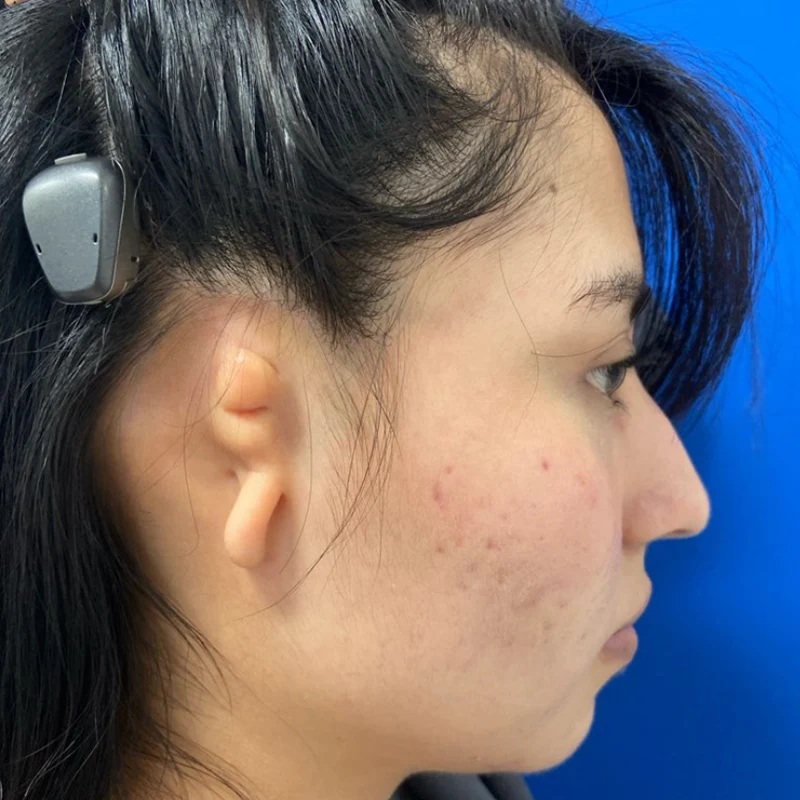
Preoperative photograph of a patient with a lobular-type microtia. She previously had a bone-anchored hearing aid placed by neurotologist Zachary Schwam, MD, Assistant Professor, Otolaryngology, Icahn School of Medicine.
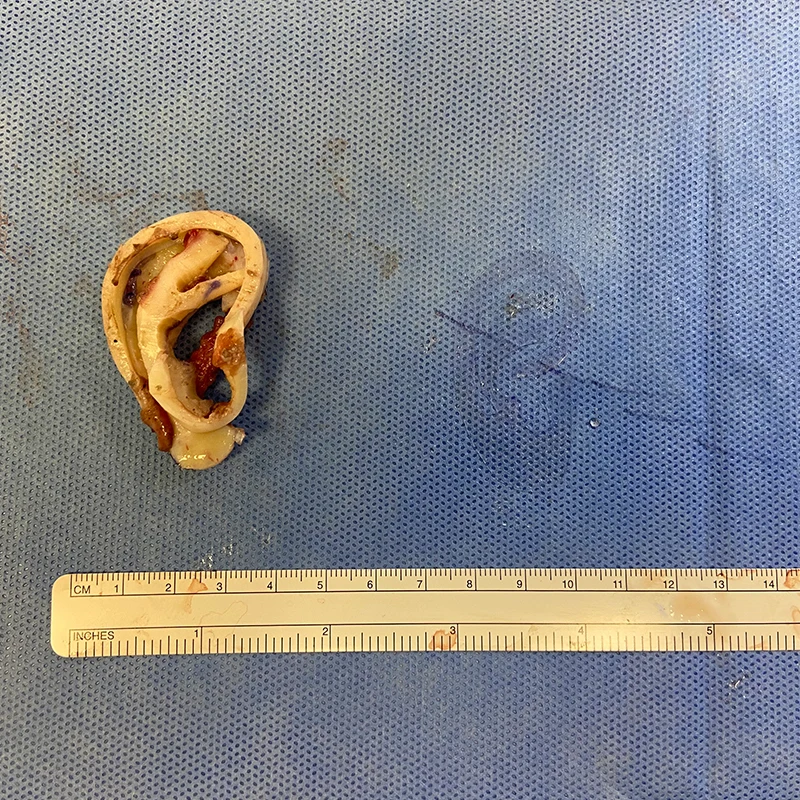
Using the template as a guide, the cartilages are carved into the three-dimensional shape of an ear.
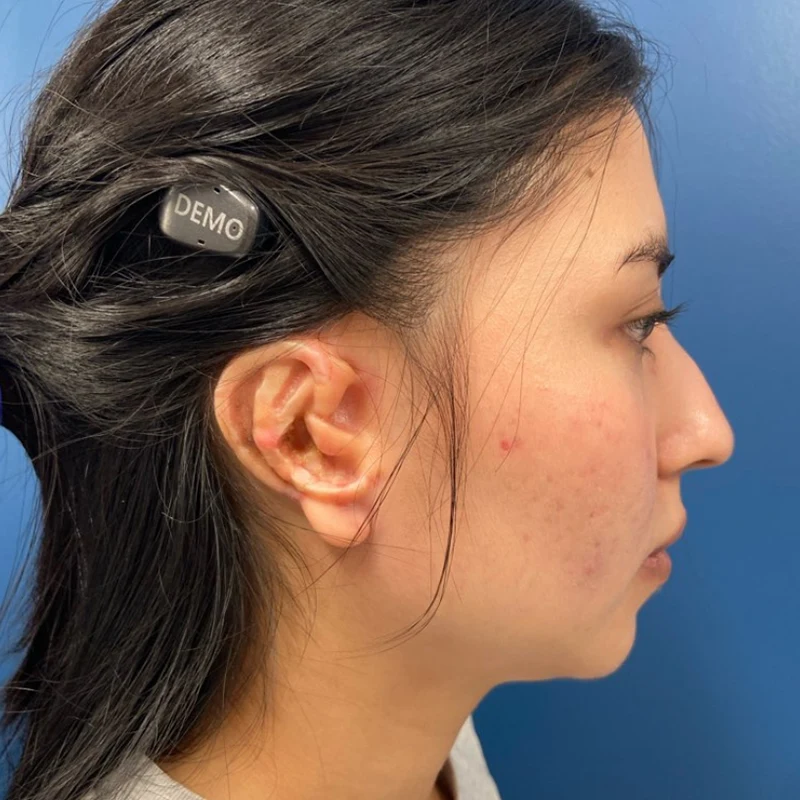
The patient is seen eight months after her stage 1 reconstruction and is ready for stage 2 to lift forward the framework.
In the first stage of the two-part reconstruction, Dr. Gray harvests rib cartilage from the patient’s chest wall to create the framework of an ear. Using a template made from the patient’s unaffected ear, Dr. Gray carves the cartilage, then places it flat against the skull, under the patient’s skin. She then inserts drains at the site to create suction, which pulls the skin down around the curvature of the new ear framework. She then banks any extra pieces of cartilage in a subcutaneous pocket overlying the chest wall to use in the second stage of the procedure.
The ear remains tucked under the skin for around six months while it heals and establishes a healthy blood supply. Then, in a second surgery, Dr. Gray lifts the ear from the skull and braces it with small pieces of banked cartilage so the new ear protrudes naturally from the head. This is then covered with a skin graft.
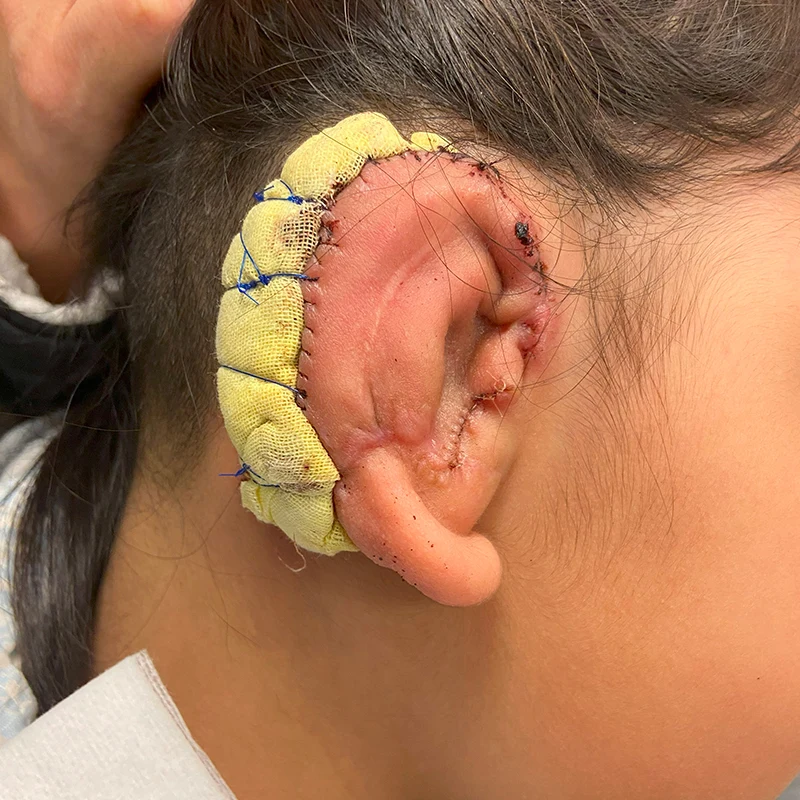
During the second stage of microtia reconstruction, the framework is elevated. Rib cartilage that is banked under the skin is used to wedge the framework forward and a skin graft is placed over vascularized tissue.

A natural appearing ear is one that has recognizable structures that are well elevated away from the skull. Skin graft discoloration fades over time.
Some plastic surgeons use polyethylene implants rather than rib cartilage to create an ear. Dr. Gray prefers using a patient’s own tissues since implants have a risk of rejection and extrusion. Implants also require a vascularized flap for reconstruction, she adds. Using rib tissue, however, is technically challenging.
“The surgery involves a lot of artistry as well as mathematical components,” Dr. Gray explains. “There are a lot of angles that are very important. If you’re off by just a few degrees, the ear won’t look right.”
During the healing process, patients must avoid putting pressure on the ear. They must follow post-surgical instructions closely to avoid infection or a breakdown of the skin overlying the framework. Dr. Gray and her team are very hands-on during the healing period, seeing patients in the clinic frequently and calling and texting with them outside of those appointments to answer questions and quickly address any complications.
Treatment Timing
At the Ear Institute, the multidisciplinary microtia team works closely to determine the optimal timing of surgeries and interventions. When possible, they combine procedures to minimize the number of times a patient is given general anesthesia. For instance, Dr. Gray says her colleagues can implant a bone-anchored hearing aid while she performs the shorter second-stage microtia reconstruction procedure. “Everyone’s needs are different, so there are a lot of discussions within our team to determine which interventions to do and the best time to perform them,” she adds.
It is also important to involve children in those discussions, she says. Some kids might not feel ready for surgery, and some may not be interested in surgical reconstruction at all. “Deciding to surgically alter someone’s face isn’t something to take lightly. We recognize the importance of making this decision collectively with patients and their families,” she says.
Dr. Gray also cautions patients that an ear created by a surgeon will never look or feel like a natural ear. “We still haven’t mastered tissue engineering to perfectly recreate something that has only been made in the womb,” she says.
Still, most patients are satisfied with their new appearance and improved functions—such as wearing glasses that rest on both ears. “Our goal is that when patients meet someone new, their ear isn’t the first thing people notice,” she says.
One welcome exception: Two of Dr. Gray’s patients recently met while at audiology appointments at New York Eye and Ear Infirmary of Mount Sinai. The children bonded over showing one another their brand-new ears.
Advancing Microtia Research
In addition to her surgical practice, Dr. Gray offers neonatal ear molding, a nonsurgical intervention to correct minor ear deformities in newborns. The technique involves creating a custom silicone splint to reshape the ear during the first month or two of life, when the cartilage is still pliable.
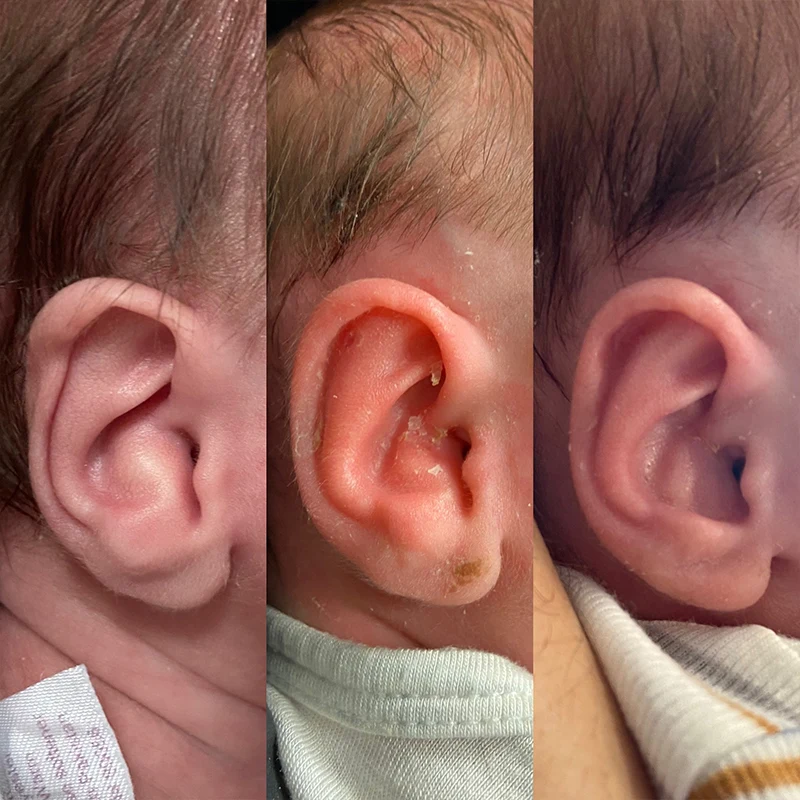
Newborns with abnormal ear anatomy can be treated with noninvasive ear molding, a procedure that reshapes the ear over the course of a few weeks.
She is also hoping to launch new research projects related to microtia. For example, she has noticed that children with microtia often have other abnormalities of the head and face, such as a weakened facial nerve or a slightly smaller skull on the affected side. In collaboration with Maura Cosetti, MD, Director of the Ear Institute and the Cochlear Implant Program at the Mount Sinai Health System, Dr. Gray is planning a new project to explore the link between microtia and skull deformities, tapping into the library of images from microtia patients treated at New York Eye and Ear Infirmary of Mount Sinai.
That number is growing slowly but steadily, with Dr. Gray devoting one day each month to ear reconstruction surgeries—a relatively high volume, given that microtia affects just one of every 7,000 to 10,000 babies born.
“For better or worse, these are rare procedures,” she says. “But they can be very rewarding if done the right way for the right patient.”
Featured

Mingyang L. Gray, MD
Assistant Professor, Facial Plastic and Reconstructive Surgery
